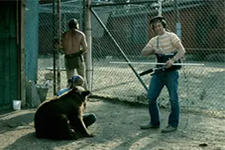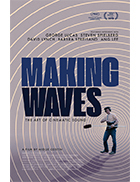Making Waves: The Art of CInematic Sound
|

Like many, many others-casual moviegoers and dedicated cinephiles alike-I tend to take sound in the movies for granted. Perhaps it is because our initial association with movies is visual (they are moving pictures, after all), or perhaps it is because soundtracks have become so incredibly detailed that they blur into our experience such that they become invisible. Either way, I am all too often unaware of the details, nuances, and sophistication of modern movie soundtracks with their layers and layers of carefully orchestrated sounds. That does not mean that soundtracks are not effective and that they do not have a profound impact on my experience-quite the opposite, in fact. It is perhaps one of the greatest compliments one can pay to the talented and studied maestros in charge of sound mixing, editing, and effects that we don't always consciously notice their work. The irony when it is good, movie sound can slip right past our conscious mind and indelibly shape our unconscious experience, whereas bad sound sticks out like a sore thumb, distracting us from the drama on-screen and reminding us of the constructed nature of our experience. Midge Costin's highly entertaining new documentary Making Waves: The Art of Cinematic Sound aims to pull back the curtain on the creation of the movie sound experience, drawing our attention to the intricacies of what goes into generating an effective soundscape for not just big action, science fiction, and fantasy blockbusters (the kind that always seem to win the sound Oscars), but also intimate dramas (Robert Redford's Ordinary People), musicals (the 1976 remake of A Star is Born), and historical epics (Ava DuVernay's recent Selma). Costin, who is making her directorial debut, knows all about sound, as she worked for a decade and a half as a sound editor on some two dozen films in the 1980s and '90s, primarily Jerry Bruckheimer-produced action movies like Days of Thunder (1990), Crimson Tide (1995), The Rock (1996), and Armageddon (1998). She now teaches at USC's School of Cinematic Arts, where she is the Kay Rose Professor in the Art of Dialogue & Sound Editing. She and writer Bobette Buster (a script consultant and Professor of the Practice of Digital Storytelling at Northeastern University) structure the film as a history about the evolution of the art of sound, beginning with Thomas Edison's invention of the phonograph, through early experiments in synchronized sound and the creation of live sound effects during theatrical screenings of major films like Wings (1927), to the eventual success of synchronized sound technologies in the late 1920s and the emergence of the sound effects editor, whose job is to create the soundtrack (those without a lot of knowledge about how movies are made will likely be shocked to learn just how little of a movie's soundtrack is recorded during principal photography, including dialogue). We learn about the crucial innovations of Murray Spivak, who broke from the tradition of using the studio's sound library to record, mix, and create unique and interesting new sounds and effects for King Kong (1933), and Orson Welles, who brought his extensive experience on the radio to movies like Citizen Kane (1941). The bulk of the film follows the careers of three defining sound editors: Walter Murch, Ben Burtt, and Gary Rydstrom, each of whom left a deep, lasting imprint of the way movies sound by moving away from the studio-factory norms of soundtrack creation and innovating new soundscapes and approaches to recording and mixing. Each of them is interviewed at length, discussing his personal history and how his career developed and evolved. Murch talks about how his early fascination with sound editing was reinforced by his discovery of Pierre Henry and Pierre Schaeffer's Musique concrte , and Burtt talks about recording Saturday morning cartoons and Errol Flynn movies with a microphone held up to the television speaker. Each of them emerged professionally at a crucial moment in cinema history, with Murch being deeply involved in the American New Wave of the late '60s and early '70s (he worked extensively with Francis Ford Coppola on The Godfather, The Conversation, and Apocalypse Now), while Burtt was a key figure in the development of the new blockbusters via his work with George Lucas on Star Wars, work that Gary Rydstrom then took into the digital realm with his extensive work on early Pixar films. When Making Waves is at its best, it shows us how each of these men is a unique artist who has helped develop and shape the constantly evolving artform of movie sound, taking it in new and previously unimagined directions, but always in the service of strengthening the immersive experience of the cinema. Costin was able to wrangle interviews with dozens of other cinematic luminaries (including a lot of the directors with whom Murch, Burtt, and Rydstrom have worked)-Steven Spielberg, George Lucas, Christopher Nolan, Ryan Coogler, David Lynch, Peter Weir, Ang Lee, and Barbara Streisand, the latter of whom speaks about the soundtrack for A Star is Born, which she produced and starred in and was, at her insistence, one of the first films to be released in Dolby stereo surround (a distinction that is usually erroneously attributed to Star Wars, which came out the next year). She also interviews numerous sound designers, editors, and mixers with literally hundreds of credits, including Greg Hedgepath, Bobbi Banks, Richard Hymns, Cece Hall, and Pat Jackson-all names you probably don't know, but who have nonetheless been instrumental in shaping your moviegoing experience. I am always a bit wary about recommending documentaries about filmmaking because I worry that my own preoccupations with the artform make me more interested than the casual moviegoer, but I have a hard time imagining anyone who has ever enjoyed a good movie not finding Making Waves a fascinating, engrossing, and deeply informative experience. You will never look at cinematic sound the same. Copyright © 2019 James Kendrick Thoughts? E-mail James Kendrick All images copyright © Goodmovies Entertainment |
Overall Rating: 


 (3.5)
(3.5)
Subscribe and Follow
Get a daily dose of Cambodian Times news through our daily email, its complimentary and keeps you fully up to date with world and business news as well.
News RELEASES
Publish news of your business, community or sports group, personnel appointments, major event and more by submitting a news release to Cambodian Times.
More Information
